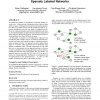101 search results - page 3 / 21 » Why collective inference improves relational classification |
101
click to vote
EMNLP
2010
14 years 10 months ago
2010
Several recent discourse parsers have employed fully-supervised machine learning approaches. These methods require human annotators to beforehand create an extensive training corp...
FLAIRS
2010
15 years 2 months ago
2010
When data instances are inter-related, as are nodes in a social network or hyperlink graph, algorithms for collective classification (CC) can significantly improve accuracy. Recen...
105
click to vote
CVPR
2006
IEEE
16 years 2 months ago
2006
IEEE
A system that could automatically analyze the facial actions in real time have applications in a number of different fields. However, developing such a system is always a challeng...
115
click to vote
KDD
2008
ACM
16 years 21 days ago
2008
ACM
We address the problem of classification in partially labeled networks (a.k.a. within-network classification) where observed class labels are sparse. Techniques for statistical re...
SIGIR
2005
ACM
15 years 5 months ago
2005
ACM
We consider classification of email messages as to whether or not they contain certain “email acts”, such as a request or a commitment. We show that exploiting the sequential ...


